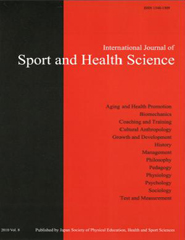最新号
選択された号の論文の14件中1~14を表示しています
- |<
- <
- 1
- >
- >|
-
2024 年 22 巻 p. 1-4
発行日: 2024年
公開日: 2024/02/09
[早期公開] 公開日: 2024/01/24PDF形式でダウンロード (938K) -
2024 年 22 巻 p. 5-14
発行日: 2024年
公開日: 2024/03/06
[早期公開] 公開日: 2024/02/09PDF形式でダウンロード (827K) -
2024 年 22 巻 p. 15-24
発行日: 2024年
公開日: 2024/03/09
[早期公開] 公開日: 2024/02/14PDF形式でダウンロード (979K) -
2024 年 22 巻 p. 25-33
発行日: 2024年
公開日: 2024/03/12
[早期公開] 公開日: 2024/02/09PDF形式でダウンロード (788K) -
2024 年 22 巻 p. 34-41
発行日: 2024年
公開日: 2024/03/12
[早期公開] 公開日: 2024/02/19PDF形式でダウンロード (853K) -
2024 年 22 巻 p. 42-52
発行日: 2024年
公開日: 2024/03/30
[早期公開] 公開日: 2024/02/19PDF形式でダウンロード (855K) -
2024 年 22 巻 p. 53-60
発行日: 2024年
公開日: 2024/04/24
[早期公開] 公開日: 2024/02/14PDF形式でダウンロード (722K) -
2024 年 22 巻 p. 61-75
発行日: 2024年
公開日: 2024/05/23
[早期公開] 公開日: 2024/04/12PDF形式でダウンロード (2749K) -
2024 年 22 巻 p. 76-85
発行日: 2024年
公開日: 2024/05/23
[早期公開] 公開日: 2024/03/29PDF形式でダウンロード (997K) -
2024 年 22 巻 p. 86-96
発行日: 2024年
公開日: 2024/05/23
[早期公開] 公開日: 2024/05/01PDF形式でダウンロード (830K) -
2024 年 22 巻 p. 97-102
発行日: 2024年
公開日: 2024/05/25
[早期公開] 公開日: 2024/05/02PDF形式でダウンロード (691K) -
2024 年 22 巻 p. 103-107
発行日: 2024年
公開日: 2024/06/27
[早期公開] 公開日: 2024/05/17PDF形式でダウンロード (627K) -
2024 年 22 巻 p. 108-122
発行日: 2024年
公開日: 2024/07/13
[早期公開] 公開日: 2024/07/04PDF形式でダウンロード (834K)
JSPEHSS Distinguished Research Award for Early Career Contribution 2023
-
2024 年 22 巻 p. A1-A18
発行日: 2024年
公開日: 2024/07/23
PDF形式でダウンロード (809K)
- |<
- <
- 1
- >
- >|
